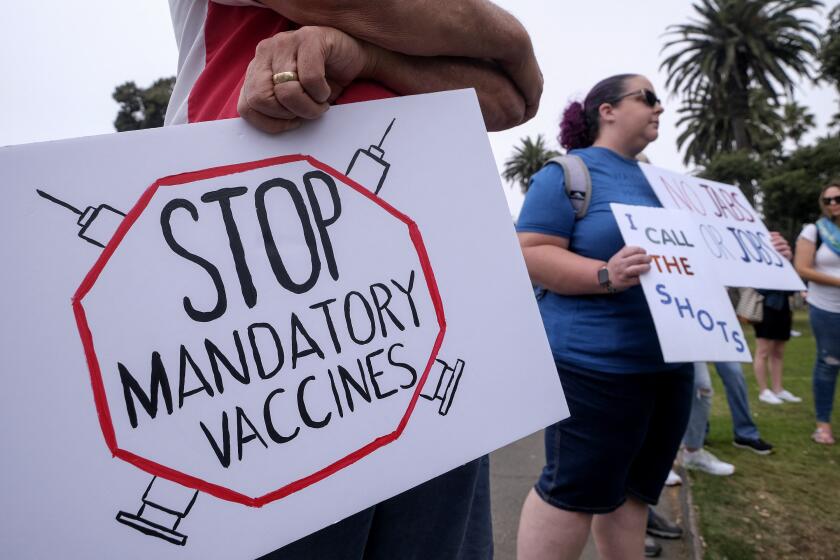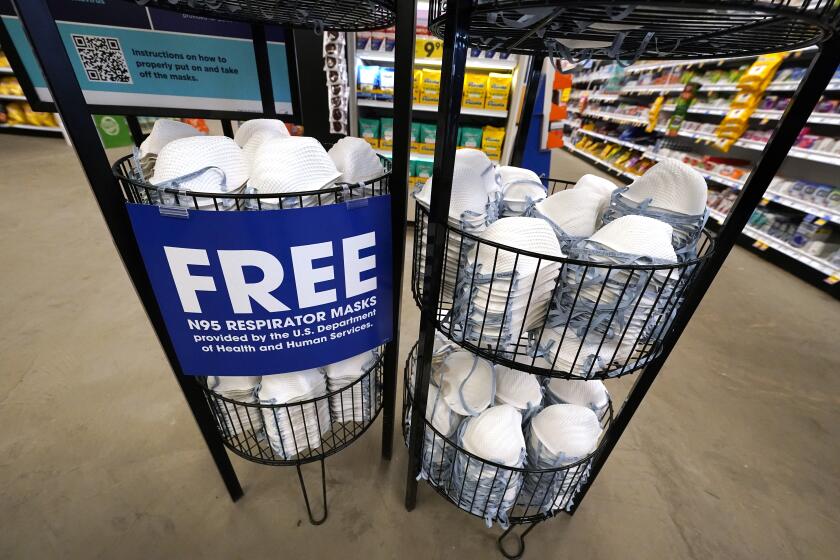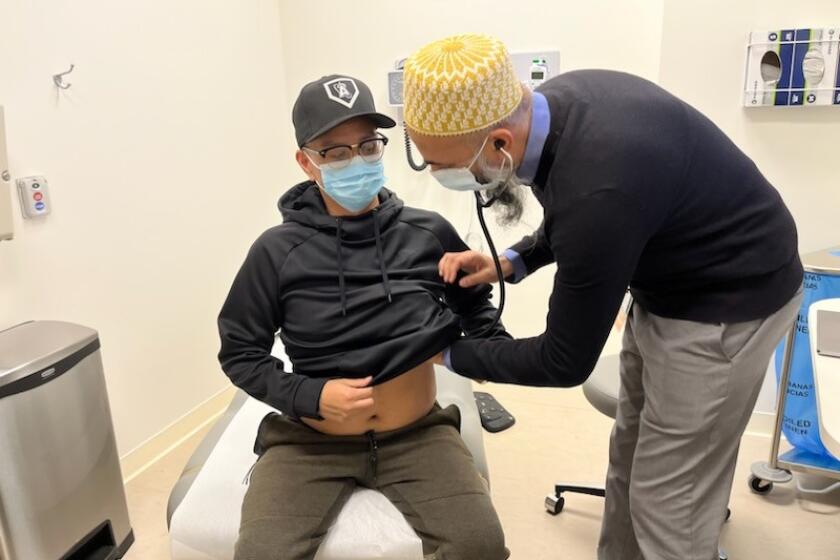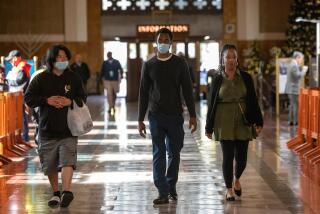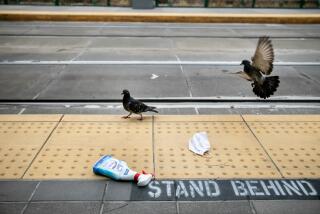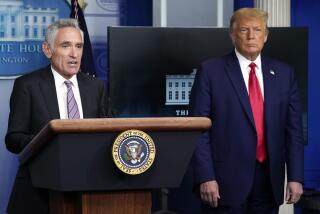
- Share via
The pandemic’s formal end in the U.S. on May 11 marks neither victory nor peace: It’s a cessation of hostilities with a dangerous virus that is still very much with us.
To maintain such an uneasy truce, Americans will have to stay protected enough to prevent humanity’s viral foe from staging a breakout in our shaky accord.
Providing that assurance, in turn, assumes that scientists and public health officials all agree on what it means to be “protected enough,” and that they can tell whether people are meeting that mark.
On both counts, the nation’s readiness to monitor this armistice falls short.
The trouble is no one has a clear fix on the extent of Americans’ immunity to the virus that causes COVID-19. And beneath that lies a more fundamental problem: Scientists and public health officials still have not settled on what it means to be immune or adopted a common yardstick for measuring it.
The Path from Pandemic
This is the fifth in an occasional series of stories about the transition out of the COVID-19 pandemic and how life in the U.S. will be changed in its wake.
“We’re always at the point of having to make decisions without that data,” Dr. Hayley Gans, a Stanford infectious disease doctor who advises the Food and Drug Administration on vaccine policy, said in a recent public meeting convened by the agency.
There are some reassuring trends. Hospitalizations for COVID-19 have plummeted, and weekly deaths from COVID-19 have fallen 90% from their most recent peak just over a year ago.
But that’s just “a snapshot in time,” said Dr. Cody Meissner, a Dartmouth College pediatric infectious disease physician who’s on the FDA’s advisory panel for vaccines. The coronavirus’ knack for surprises makes scientists wish they understood COVID-19 immunity well enough to anticipate its next move.
Scientists have one measure of immunity that’s backed by decades of research: counting antibodies. It’s easy and inexpensive to do with lab tests that are readily available.
Toting up the immune proteins that form in the wake of vaccination or infection is one way to assess how quickly a person could be expected to block or clear an infection. The more antibodies, the more thorough their protections.
Americans who still aren’t fully vaccinated against COVID-19 probably have some immunity from a past infection. They may not be so dangerous anymore.
For insights into the nation’s immunity as a whole, scientists measure coronavirus antibodies in large groups of people, such as patients who had blood drawn for routine laboratory tests or volunteers who made donations to blood banks.
These seroprevalence surveys have shown that by June 2022, 94% of American adults — and roughly as many children — had been vaccinated, infected or both.
For a while, officials hoped high levels of antibodies would drive the virus out of circulation altogether. Once enough Americans were vaccinated, the reasoning went, antibodies would block so many infections that the coronavirus would just die out for lack of new victims to infect.
But as the pandemic unfolded, hopes of reaching this state of “herd immunity” were dashed.
All virus-specific antibodies “decay” with time, leaving behind a template to make more when needed. But that renewal process takes time, and the Delta and Omicron variants proved adept at establishing infections before the body’s defenses were in place.
Over time, it became clear that antibodies alone weren’t telling the whole story of Americans’ immunity. People who’d been vaccinated or previously infected were coming down with COVID-19. But they weren’t becoming severely ill or dying at nearly the same rate as people who had no immune protection. Some other process was at work.
That unseen mechanism was what scientists call cellular immunity, and its foot soldiers are T cells.

Dr. Dan H. Barouch, an immunologist at Harvard, calls T cells “the unsung heroes” of the immune system. They do the close-in work of hunting down and killing cells that have been invaded and hijacked by the coronavirus.
Cellular immunity is widely credited with staving off the worst ravages of COVID-19. Even for some whose weakened immune systems mounted an anemic antibody response to vaccination, cellular immunity can kick in robustly and protect against death.
As new mutations helped the coronavirus evade antibodies, T-cell responses seemed to remain strong in the face of new variants, including the many varieties of Omicron.
There’s also encouraging evidence that this cellular immunity is long-lasting. Scientists have confirmed strong T-cell responses a year after SARS-CoV-2 infection and at least six months after vaccination.
What’s more, patients who were infected with the SARS-CoV coronavirus — a close relative to the pandemic virus that was responsible for the 2003 outbreak of severe acute respiratory syndrome — have shown signs of T-cell immunity 17 years later.
All this has made University of Pennsylvania vaccine expert Dr. Paul Offit question the value of repeated booster shots as a means of maintaining Americans’ protection against COVID-19.
Evidence has mounted that most Americans’ immunity now relies more on T cells than it does on propping up antibody levels, Offit said. As a result, the U.S. government’s strategy of repeated vaccine booster shots is probably unnecessary for all except patients with weakened immune systems, he added.
Offit acknowledged that each jab increases antibody levels. But it’s not clear that those additional antibodies reduce the likelihood of severe illness or death, which by now should be the definition of “protected,” he said.

Meissner goes further.
“This virus is like the wind — you can’t stop the wind,” he said. “It’s going to continue to mutate and become more infectious. But as long as we can protect against severe disease at this stage of the pandemic, I can live with that.”
At a recent meeting called by the FDA to consider vaccine strategies going forward, Offit, Meissner and others challenged the agency to make clear what the shots are meant to accomplish, and what metric it will use to judge them.
“We need to define what we want from this vaccine,” Offit said at the meeting. If it’s to protect against severe disease and death, “T cells are important.”
Unfortunately, the status of a person’s cellular immunity is more difficult to capture and quantify. There are tests that measure these immune cells, but they’re neither cheap nor simple to perform.
The denizens of the cellular immune system are a diverse lot whose functions shift with time and circumstances. Key details about how this complex system responds to the coronavirus still elude scientists, Meissner said.
“We don’t know which of those T cells are integral in protecting against a respiratory virus,” he said. “So it isn’t easy to look at T cells and ask if we have sufficient numbers of them to protect.”
If the U.S. public health emergency ends, Americans would be vulnerable to a new coronavirus variant that sparks another COVID-19 surge.
There are tests that capture cellular immunity, but they’re very expensive to run. Most require a large volume of a person’s blood, special chemical reagents and complex manipulation to produce results. Many demand highly skilled lab workers or extensive computational resources to yield useful data.
As a result, they’re used sparingly in the treatment of patients. And they’re never used to test broad populations.
If a lab test were able to measure cellular immunity as easily as antibodies, “that would spread like wildfire, because everyone is searching for one,” Meissner said.
Such a test could not only assess whether a person needed a booster shot but also spur a return to public health measures such as social distancing and masking. If T-cell protections have fallen across populations, it might even alert vaccine makers that they need to update the composition of vaccines to better match the circulating strain.
One such test may be a start.
In August, the European Medicines Agency gave its blessing to a commercial assay that offers a simple way for scientists and public health officials to measure T-cell immunity.
The test’s advertised use is to give immunocompromised patients a reading on whether they’re at high risk of becoming severely ill or dying if they catch the coronavirus. But public health officials in Spain used it to assess the immunity of Madrid’s residents after most had received a vaccine and multiple waves of COVID-19 had swept through the city.
For 40 consecutive days, phlebotomists collected 100 blood samples a day. Each night, the samples were processed by a single lab technician working with a PCR machine, a standard fixture in virtually any commercial testing lab. The results provide a yes/no answer to the question of whether there is a cellular immune response to the SARS-CoV-2 virus.
“Even my 12-year-old son can perform the test,” said Jordi Ochando, an immunologist at Mount Sinai’s
Icahn School of Medicine in New York who oversaw the Madrid survey. The results can be available within a day of blood collection and instantly uploaded for analysis, sharing and storage, he added.
Ochando quickly got his answer: At an average of 10 months post-vaccination, 90.2% of the tested population still showed a cellular immune response to the pandemic virus.
When everyone around them stops taking pandemic precautions, it gets harder for immunocompromised Americans to protect themselves against COVID.
The test, devised by the British biotech company Hyris, is far from exhaustive. It doesn’t do a T-cell count or survey their strength or diversity, as some lab tests do. And instead of detecting the cellular immune system’s response, it looks for a genetic signal that reveals such activation.
But it is easy, and cheap to use. In Europe, the per-person cost is “on a par with a standard PCR test” for COVID-19, said Hyris founder and Chief Executive Stefano Lo Priore.
“It’s a way — the only scalable way we have now — to quantify cellular immunity,” said Ernesto Guccione, a Mount Sinai immunology researcher who helped design the test and has a patent pending.
Such a test could make it affordable to gauge cellular immunity in residents of a boarding school, a nursing home or a city, Lo Priore said. The results could help officials decide whether to drop or reinstate public health measures such as indoor mask mandates, or guide the timing of booster shots.
In time, Guccione said, the test could be used alongside other assays to reveal more about how T cells protect and for how long. It must pass muster with the FDA before it can be marketed in the United States, a process for which the company is currently preparing.
Guccione and Ochando have their sights next on measuring the T-cell immunity of New York City, which has repeatedly been the pandemic’s epicenter in the United States.
Los Angeles could come next, Ochando said.
